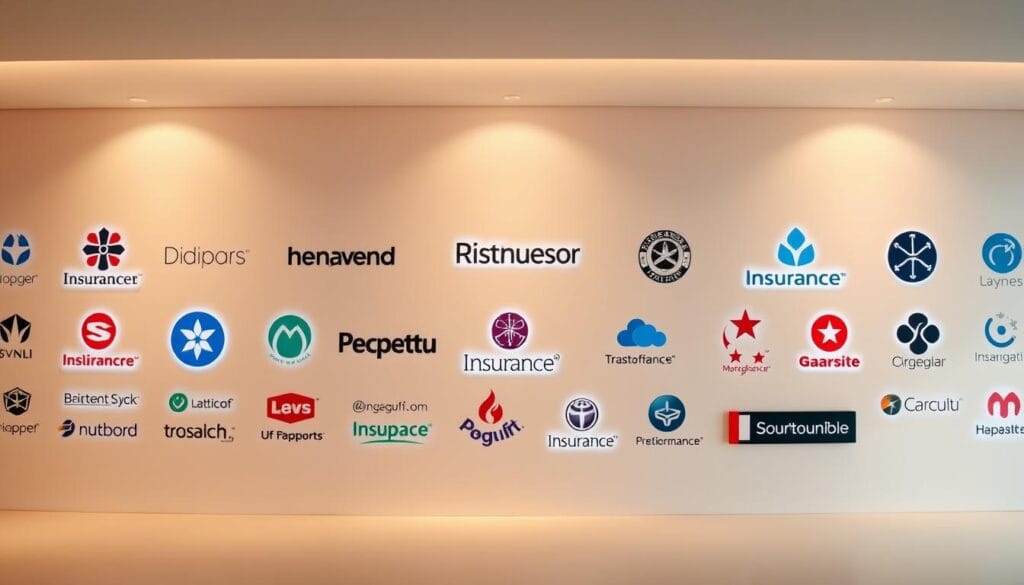Small and medium-sized businesses (SMBs) often face challenges in securing the right coverage. According to Business Insider, 70% of SMBs lack critical insurance due to transparency issues and poor customer experiences. This gap highlights the need for innovative solutions in the industry.
Digital platforms are stepping up to address these accessibility issues. Companies like Next Insurance are leading the way, with 650,000 monthly website visits. These platforms combine advanced technology with user-friendly interfaces to simplify the process of obtaining coverage.
The FAB Score methodology is a key metric for evaluating these providers. It combines funding, traffic, and operational scale to rank companies objectively. This approach ensures that businesses can make informed decisions when choosing their insurance solutions.
Looking ahead to 2025, trends like embedded insurance platforms and AI-driven customer experiences are set to reshape the market. These advancements promise to make coverage more accessible and tailored to individual needs. For more insights, explore our insurance solutions.
Key Takeaways
- 70% of SMBs lack critical coverage due to transparency and customer experience issues.
- Digital platforms are addressing accessibility challenges for businesses.
- The FAB Score methodology ranks providers based on funding, traffic, and scale.
- Next Insurance leads with 650,000 monthly website visits.
- Embedded insurance and AI-driven experiences are key trends for 2025.
The Rise of Digital Insurance in 2025
In 2025, the way businesses secure coverage will be transformed by innovation. The insurance industry is evolving rapidly, driven by advancements in technology and changing consumer preferences. One of the most significant shifts is the rise of embedded solutions, which are projected to grow from $150 billion in 2024 to $700 billion by 2029.
API integration is playing a crucial role in this transformation. For UK insurers, this technology has reduced customer acquisition costs by 75%. By embedding coverage into existing platforms, companies can streamline the process and make it more accessible to users.
Millennials and Gen Z are also shaping the future of the industry. Their preference for mobile-first platforms is pushing companies to adopt user-friendly, tech-driven solutions. This shift is evident in the success of platforms like Lemonade, which achieved a $2 billion valuation through its AI-driven model.
Another key trend is the move from legacy systems to cloud-based policy management. This transition allows businesses to operate more efficiently and scale their operations. According to Aperture, $5 trillion will be distributed through non-insurance channels via embedded solutions in the coming years.
The digital transformation of the insurance industry is accelerating. Businesses are adopting new solutions to meet the demands of a tech-savvy generation. The process of securing coverage is becoming simpler, faster, and more tailored to individual needs.
Best Digital Insurance Providers Ranked by Performance

Leading companies are redefining how businesses access essential protection. These platforms combine advanced technology with tailored solutions to meet diverse needs. Metrics like funding, claims efficiency, and niche expertise set them apart.
Next Insurance: Leader in Small Business Coverage
Next Insurance stands out with $1.1 billion in funding and a 4.0 Trustpilot rating. Its platform focuses on simplifying coverage for small businesses, offering seamless claims processing. With 75 million YouTube views, the company has built a strong digital presence.
Pie Insurance: Simplifying Commercial Policies
Pie Insurance has raised $621 million and partnered with over 1,000 agencies. Its platform specializes in commercial policies, making it a go-to for businesses. A 4.0 Trustpilot rating from 597 reviews highlights its customer-centric approach.
Coalition: Cyber Insurance Innovator
Coalition has secured $770 million in funding and achieved a $325 million premium run rate. Known for its cyber expertise, the platform has grown premiums 9x since 2020. With 51,000 LinkedIn followers, it continues to expand its reach.
These companies exemplify innovation in the industry. Their platforms are designed to meet specific business needs, from small business coverage to cyber protection. For more insights, explore our latest blog.
Why Embedded Insurance Is the Future
Embedded insurance is reshaping how industries deliver tailored solutions. By integrating coverage into everyday transactions, this approach is transforming the market. From eCommerce to travel, point-of-sale integration models are gaining traction.
In eCommerce, device protection is offered at checkout, while travel platforms provide trip cancellation options. These contextual offers increase purchase intent by 25%. Businesses benefit from streamlined operations and enhanced customer engagement.
Implementation models vary, with API-first and open-source platforms leading the way. Cover Genius uses an API-first approach, ensuring seamless integration. Openkoda, on the other hand, offers customizable open-source solutions, reducing development costs by 60%.
“Embedded insurance is not just a trend; it’s a fundamental shift in how businesses deliver value to their customers.”
Qover’s multinational compliance framework serves over 60 countries, making it a global leader. Bsurance excels in real-time POS integration for automotive and consumer goods sectors. These platforms highlight the versatility of embedded solutions.
| Implementation Model | Key Features | Use Case |
|---|---|---|
| API-First | Seamless integration, global compliance | Cover Genius |
| Open-Source | Customizable, cost-effective | Openkoda |
For more insights on how embedded insurance is shaping the future, explore our latest trends.
Top Embedded Insurance Platforms to Watch

Innovative platforms are transforming how businesses integrate coverage into their operations. These solutions are designed to meet diverse needs, offering flexibility and efficiency. Two standout examples are Openkoda and Cover Genius, each bringing unique strengths to the table.
Openkoda: Customizable Open-Source Solutions
Openkoda’s open-source platform enables businesses to deploy tailored solutions 60% faster than proprietary systems. Its AI-driven reporting features optimize policy management, ensuring businesses can adapt quickly to changing needs. Additionally, Openkoda offers hosting flexibility, allowing companies to choose between self-managed and cloud options.
Cover Genius: Global Compliance Expertise
Cover Genius operates in over 60 countries, providing localized compliance frameworks for seamless integration. Its XCover platform excels in financial services integration, addressing complex compliance challenges. This multinational infrastructure ensures businesses can expand globally without regulatory hurdles.
Both platforms exemplify the future of embedded insurance, offering scalable and efficient solutions. For more insights on how these platforms are shaping the industry, explore our latest analysis.
Customer Experience: The Key Differentiator

Customer experience is now a critical factor in shaping business success. Companies like Thimble and INSHUR are setting benchmarks with their Trustpilot ratings of 4.5 and 4.3, respectively. These platforms demonstrate how prioritizing customer experience can drive loyalty and growth.
Evaluating CX metrics is essential for understanding performance. For instance, Embroker attracts 110,000 website visits monthly, while Vouch sees 15,000. Such data highlights the importance of a seamless process in attracting and retaining customers.
AI implementations are revolutionizing how companies interact with their customers. Lemonade’s behavioral economics model and Haven Life’s price comparison tools are prime examples. These technology advancements enhance personalization and efficiency.
Support channels also play a vital role. Hippo’s Facebook Messenger integration and Clearcover’s 60% digital claims rate showcase how technology can streamline customer interactions. Jetty’s B2B2C model, combining lease guarantees with renters insurance, further emphasizes the value of innovative solutions.
Trustpilot remains a critical reputation metric across providers. Platforms with high ratings often excel in data analytics and customer-centric strategies. For more insights on improving customer experience, explore this analysis.
How to Choose the Right Digital Insurance Provider

Selecting the right insurance solution requires careful evaluation of key factors. Businesses must consider metrics like funding, scalability, and compliance to ensure their needs are met. The FAB Score, which combines funding (30%), traffic (25%), team size (20%), and social proof (25%), provides a reliable framework for decision-making.
Compliance coverage is a critical factor. For example, Cover Genius operates in over 60 countries, offering localized solutions that meet regulatory standards. This ensures businesses can expand globally without facing legal hurdles.
Scalability is another essential consideration. Openkoda’s modular architecture allows businesses to deploy tailored solutions 60% faster than proprietary systems. This flexibility is crucial for companies looking to adapt quickly to changing needs.
“The right provider not only meets your current needs but also scales with your business.”
Cost structures vary significantly across providers. Next Insurance, with a $4 billion valuation, offers robust solutions for small businesses, while Pie Insurance focuses on commercial policies with $100 million in lifetime premiums. Analyzing these costs helps businesses align their budgets with their coverage requirements.
Implementation timelines also play a role. API integration can be completed in days, whereas custom builds may take months. This efficiency is vital for businesses needing quick deployment.
| Criteria | Key Features | Example |
|---|---|---|
| Compliance | Global reach, localized frameworks | Cover Genius |
| Scalability | Modular architecture, fast deployment | Openkoda |
| Cost | Budget alignment, premium options | Next Insurance |
Data security is non-negotiable. Cloud-based solutions with regulatory certifications ensure sensitive information is protected. For more insights on choosing the right provider, explore our comprehensive guide.
Conclusion
The insurance industry is undergoing a significant shift, driven by innovation and customer-centric solutions. Companies like Next Insurance, Coalition, and Openkoda are leading the charge, each specializing in unique areas such as SMB coverage, cyber protection, and embedded tech. These platforms are setting new standards for accessibility and efficiency.
Embedded insurance is projected to grow to $700 billion by 2029, reflecting its transformative potential. Critical success factors include optimizing customer experience, as seen with Thimble, and ensuring global compliance, a strength of Cover Genius. These elements are reshaping how businesses interact with insurance solutions.
As the industry evolves, increased M&A activity is expected, following acquisitions like Travelers’ purchase of Simply Business. Businesses should evaluate providers using the FAB Score, ensuring they align with specific needs and growth goals. For more insights, explore our latest analysis.

